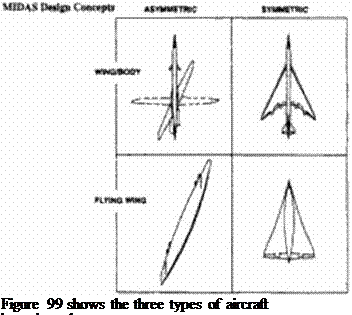Application of the Method to Supersonic Civil Transports
17.6.1 Introduction
To design a next generation of supersonic transport a global model was developed to investigate the performance potentials of a wide range of aircraft variants.
 |
Figure 99 MIDAS design concepts
a) A conventional wing-bodv configuration. This symmetric wing body <$WB) configuration is also the preferred configuration for military aircraft. In reference [367] Rcch and Leyman provide an excellent insight into the development of Concorde, the only operational supersonic transport of this type The SWB represents the conservative approach for a new sec
ond generation SST and all group-of-fivc (Boeing – MDD – NASA. DAS A – AS – BAet baseline configurations are of this type. The flying-wing as presented in Figure 99 is not a true new type since the passenger cabin is concentrated in the center of the planform and therefore not different from the conventional configuration. For these configurations the horizontal tail or canard only serves as a control surface. The horizontal tail docs not contribute to the stability because of the high downwash ratio behind the low aspect ratio wing.
b) Asymmetric (oblique) wing body configuration. First proposed in 1912 by H. dc Marcay and B. Moonen. this novel concept was later successfully developed by R T Jones at NASA Ames Research Center dunng 70’s. A large volume of work is available on oblique wing-bodies, notably references (362) (365)(358). Recently, Elliot, Hoskins and Miller at General Electric Company (360) called for a revival of the the oblique wing program because of us larger performance margins and its low environmental impact. This concept has also an appealing passenger cabin layout.
c) Asymmetric flying wing or Oblique Flying Wing OFW. First proposed by R. T. Jones (363) of NASA Ames, the OFW was described in detail in previous references by the first author (371JJ368) (369)(370) and by Waters. Ardema and Kroo (375). Ihe OFW offers a possible solution to the economic and environmental problems associated with supersonic flight due to a combination of good aerodynamic and structural characteristics. Seat modifications may be necessary to cope with a future modification of FAR 25 for an OFW w ith a spanwisc oriented cabin. Such a cabin is desired to take advantage of span loading. A proof of concept test (light was made with an unstable OFW at NASA Ames on May 10. 1994. by S. Moms and B. Tigner.













